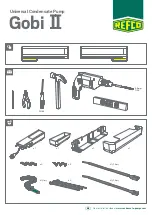
61
Final Installation Procedures
Due to our policy of continuous product innovation, some specifications may change without notification.
©LG Electronics U.S.A., Inc., Englewood Cliffs, NJ. All rights reserved. “LG” is a registered trademark of LG Corp.
FINAL INSTALLATION PROCEDURES
Performance Evaluation
Operate the unit in heating and / or cooling, depending on outdoor conditions, for 15 to 20
minutes, then check the system refrigerant charge (feature availability depends on model):
1. Measure the pressure of the gas (vapor) suction service valve. See optimum psig in table
at right.
2. Measure the air temperature from both the inlets and outlets.
3. Verify the difference between the inlet and outlet temperatures is > 14.4°F.
4. The air conditioner is now ready to use.
Outside Ambient
Temperature
Gas (Vapor) Service
Valve Pressure
95°F
120~135 psig
Test Run
After all installation procedures are complete, the system is ready for a test run. Follow the guide-
lines below.
1. Check that all drain piping, refrigerant piping, and wiring / cables are properly connected.
2. Check that both the gas (vapor) suction and liquid refrigerant piping service valves are fully open.
3. Install the batteries into the handheld remote controller (see above).
4. Turn on the power to the outdoor unit, and press and hold the On / Off button for three (3) to five
(5) seconds; this switches the system to test operation mode.
5. The system will operate in cooling with maximum air flow for 18 minutes before returning to the factory default setting. While system oper-
ates in the test operation mode, note any issues that occur, and fix as necessary.
Figure 87: Test Operation Mode.
On / Off Button
• If all modes can’t be tested all at one time, testing must be performed later when weather
conditions permit.
• If the actual pressure is higher than shown, the system is most likely overcharged, and charge
must be removed. If the actual pressure is lower than shown, the system is most likely under-
charged, and charge must be added.
Table 20: Gas Side Pressure at Optimum Condi-
tion When System is in Cooling.
Discharge
Temperature
Discharge
Air
Inlet Temperature
Figure 88: Performance Evaluation Measurement
Locations.
Installing Batteries into the Handheld Remote Controller
For information on using the handheld remote controller, refer to its owner’s manual.
1. The remote controller needs two AAA (1.5V) batteries for operation. Remove the battery cover
from the back of the remote controller by pushing the tab down in the direction seen at right.
2. Insert the two new batteries.
• Align batteries by the (+) and (-) sides.
• The interior battery compartment of the remote controller will have clear markings for the (+)
and (-) placement.
3. Verify that the batteries have clicked into the compartment and are firmly engaged with the
contacts on either side of them.
4. Reattach the back cover of the remote controller.
5. Proceed with powering on the remote controller and use as needed. Remove the batteries if system won’t be used for an extended time.
Figure 86: Installing the Remote Controller
Batteries.
Battery Cover
Battery Cover Tab
1. Slide battery cover
tab down. Lift cover
and set aside.
2. Insert Batteries.
Installing Batteries, Test Run, Performance Evaluation










































